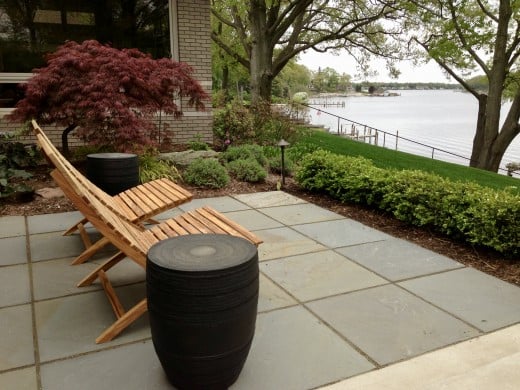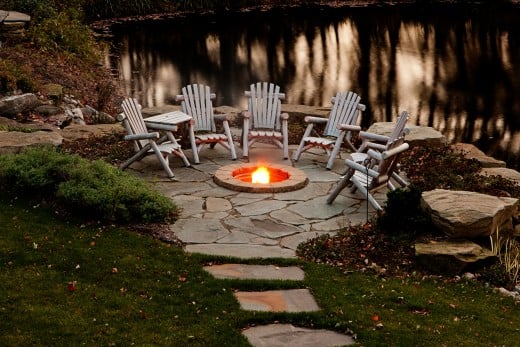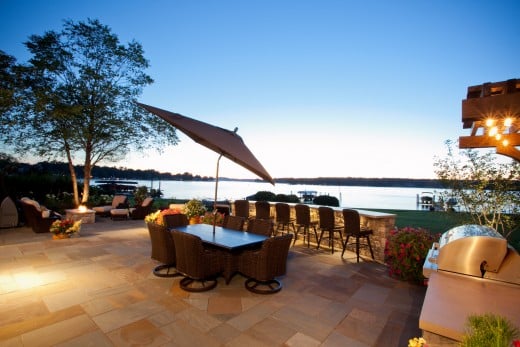How to Properly Design Your Outdoor Patio Space

Dimension: It’s all relative
There are many options to think about when sorting out the details on your patio. Remember, in all good design, form follows function. This means make your space work well first and then focus on making it look great. You can have the most beautiful (and expensive) stone available for your patio surface but if the space isn’t arranged correctly or (worse) it’s not big enough to handle the flow of traffic around your grill area, firepit, etc. then it will still seem like all that work and investment was a disappointment instead of a home run.
Whether you have a sprawling backyard with acreage to spare or a small lot, your overall patio space should be relative to what you want to have in it. Essentially, what this means is that the more elements you include (grill area, firepit, dining space, etc) all needs to accommodate the size of the pieces themselves as well as the furniture surrounding them (like chairs beside a table). Finally, remember that we need to populate these spaces with our family and friends. They need space to sit and interact as well as move about the patio area unencumbered by a grill flaring up or a cramped seating space.
I cannot stress that last point enough: Make sure your space has enough room to circulate traffic around or your backyard barbecue will feel more like a game of awkward patio twister…
Grills
Always follow manufacturers instructions for grill installation setbacks. If it’s a built-in grill in a combustable space (i.e. outdoor cabinets) then make sure the grill comes with a insulated sleeve. This has it’s own dimensions that are crucial for making the grill fit correctly with the cabinet as well as the countertop supporting the grill.
In general figure a minimum 3-6 inches of clearance around the grill for backsplashes and other elements nearby, such as a sideburner. When in doubt, always follow manufacturers instructions and consult a professional installer in your area.
Fire Pits
Fire pits can be either raised or sunk into the patio, wood burning or gas fueled. While each has various pros and cons, they all have the universal truth that fire is hot and can burn. Therefore, your patio space must accommodate room for backing up chairs to escape the heat and/or smoke and embers (if wood burning).
If your space is smaller, consider the option of a portable fire pit. This is a versatile option for making a space multi-purpose as the fire pit can be moved aside when not in use to allow for extra seating or dining space.
If the space has a dedicated fire pit that cannot be moved, consider how you and guests will hang out around the fire pit. Not all furniture is created equal in a dimensional sense, so double check your furniture size so it will work with your patio and fire pit area.
Leave approximately 2 feet (minimum) of circulation space from the front edge of the furniture to the outside edge of the fire pit. If you want to sit on your fire pit when not in use then make sure it’s at seat height which is between 18-21 inches from the patio floor to the top of the fire pit.

Outdoor Dining
Similar to fire pits, if the table fits and there’s not enough room to move chairs in and out, then the space will never feel or work properly to gain enjoyment out of it.
After considering your intended table size and chair dimensions, also consider if there’s enough room for people to get out of their chair and move around the table area. No one likes being barricaded no matter how tasty the steaks being grilled!
For example, a rectangular table seating 6-8 people will require on a space approximately 12-1/2’ by 10’ wide to accommodate the table, chairs and circulation space.
Essentially, the general rule of thumb is that if you can maintain roughly 3’6” around the outside edge of the table you should meet the minimum clearance for chairs and guests.

Go Big or Go Home... Sort of
I remember a commercial comparing a company’s new line of cars to properly designed surf boards with this slogan, “Wider is better.”
While a patio isn’t a surf board or a car, that mantra is generally true for sizing one that functions well. A more expansive patio space can make you and your guests feel more at ease to move freely from one outdoor space to the other. This is no different than organizing spaces inside your home, only it’s outside. An extra 6” on either side of a space can make the difference and likely not affect budget that much.
Since there’s many different variations on outdoor patio furniture, be sure to check dimensions before setting up your space. If you have trouble visualizing cut up some cardboard boxes and grab some outdoor marking paint (or a garden hose) and mock up your space. Use a tape measure stand in the area you want to develop. Walk around your “furniture” if it feels really cramped, then make more room.
If space is limited, consider furniture that can nest or serve as double duty to maximize the functionality of the space.
Wrapping Up
No matter what your space looks like, you have many options out there. Do your homework and map out your space before investing. Consult with a professional designer or contractor. All these avenues can help guide you into a summer of great memories ahead.








